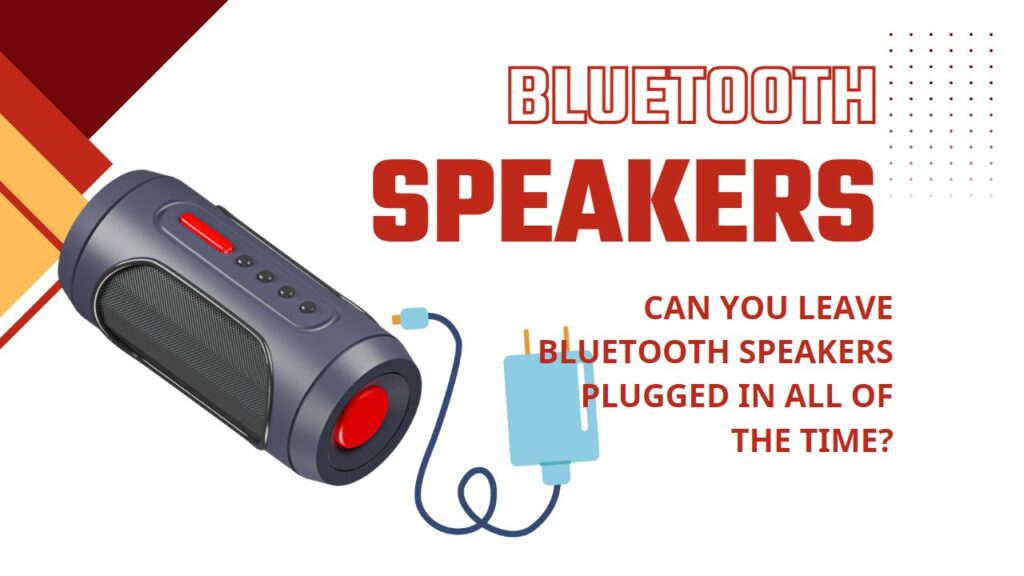In today’s fast-paced digital era, convenience is everything. We want to streamline our technology, making it more efficient and user-friendly. This expectation naturally extends to our audio devices as well, including the widely popular Bluetooth speakers. A common question that arises among users is: Can you leave Bluetooth speakers plugged in all the time?
Lithium-ion batteries are the powerhouse behind most current Bluetooth speakers, and their design ensures they don’t “overcharge” when kept plugged in incessantly. Still, it’s important to note that such continuous charging tends to exhaust the speaker’s battery lifespan more quickly when compared to an intermittent charge cycle of 80% to 25%.
Table of Contents
The Lifeline of Your Speaker: Understanding Battery Health
Every piece of technology comes with a lifespan, and Bluetooth speakers are no different. Central to these speakers’ longevity is the health and well-being of their battery, a component that dictates their operational ability.

Lithium-ion batteries power most modern Bluetooth speakers. These batteries are lauded for their rechargeability, high energy density, and absence of the “memory effect” – a battery phenomenon where the maximum energy capacity reduces over time due to repeated recharge cycles.
However, while lithium-ion batteries might be more advanced than their predecessors, they still come with a set lifespan that’s chiefly determined by the number of charging cycles they undergo.
A charging cycle refers to the process of charging a battery from 0% to 100% and then discharging it back to 0%. It’s a vital term to understand when discussing battery health as it forms the fundamental unit of a battery’s life.
Every battery is built to withstand a specific number of these cycles before its performance starts to wane. While the exact number of cycles differs depending on the manufacturer and battery type, lithium-ion batteries, it’s usually in the high hundreds or low thousands.
Like all things in life, lithium-ion batteries degrade over time. This is due to several factors, including the number of charging cycles, the temperature, and how the battery is used. However, the number of charging cycles plays a particularly pivotal role.
Each cycle puts stress on the battery, causing slight structural changes in the battery materials. Over time, these changes accumulate and begin to affect the battery’s performance, reducing its capacity to hold a charge.
To Plug-In or Not To Plug-In
In the context of leaving your Bluetooth speakers plugged in, it becomes a trade-off situation between convenience and longevity.
Sure, you can keep your speakers plugged in all the time. It ensures that your device is always charged and ready to go. Most modern devices are intelligent enough to stop charging once the battery is full, protecting against overcharging.
This feature, known as trickle charging, allows a steady flow of power that compensates for the small amount of battery that your device uses even when it’s off.
However, there is a flip side to this convenience coin. Long-term, constant connection to a power source can lead to an effect called “battery memory,” where the battery ‘forgets’ its full capacity and reduces its effective charging capacity. This can gradually wear down the battery’s lifespan and impact its overall performance.
Striking the Right Balance
It’s not about complete avoidance, but rather, intelligent usage. Adopting the most beneficial practices for your Bluetooth speakers revolves around discerning usage rather than absolute prohibition. How you manage the charging of your speakers relies largely on your usage pattern and the battery’s ability to meet those needs.
For heavy users who frequently find their speakers gasping for a charge, keeping them perpetually plugged in may seem to be a feasible option. This way, the speakers will always be ready for use, eliminating the inconvenience of waiting for them to recharge.
On the flip side, if your usage pattern doesn’t align with this scenario – perhaps you use the speakers sporadically, or they boast a robust battery life that comfortably extends over your listening sessions – it may be in your best interest, and that of your speakers, to unplug them once they reach full charge. This practice allows the battery to rest and recuperate, potentially extending its lifespan and ensuring that you get the most out of your Bluetooth speakers.
However, it’s vital to remain vigilant for signs of battery wear and tear, irrespective of your charging routine. Notable symptoms could include a drastic decrease in playtime, or your speakers overheating during charging.
These signs could be harbingers of battery degradation and should prompt a reevaluation of your charging practices. By paying heed to these signals and adjusting your habits accordingly, you can help maintain your Bluetooth speakers‘ battery health, ensuring a prolonged lifespan and enjoyable listening experience.
The Bottom Line
So, can you leave Bluetooth speakers plugged in all the time? Technically, yes. But should you? That depends. Balancing between the immediate convenience of always having a fully charged device and long-term battery health is the key.
Remember, technology serves us best when we understand and accommodate its nuances. Respect the limits of your Bluetooth speakers, and they will continue to deliver high-quality sound for many years to come.





